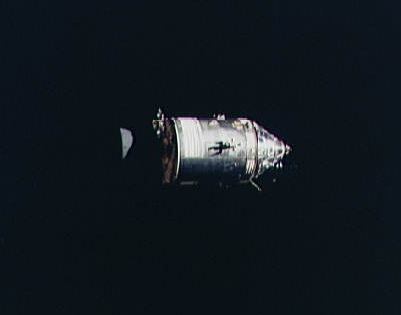A small episode of the conquest of the moon
February 1971
Apollo 14 is in orbit of the moon and is preparing to land the lunar module.

Before leaving the orbit, a couple of turns remain. The MCC in Houston checks the computer data of the lunar module and sees that the Abort switch is activated - a button for dividing the steps of the lunar module and turning on its engines (emergency take-off from the lunar surface). Houston resets this bit, but after an hour it is equal to one again, as if the button was pressed. What the hell?
The pilot of the lunar module, at the request of the MCC, knocks on the switch panel - the unit disappears. It is clear - in the button circuit the wiring hangs or a drop of solder and arbitrarily closes-opens the contact. You can’t sit with it, because when shaking, the contact will by all means close and the lunar module will take off accidentally without lapping.
Two hours remain to resolve the issue - the time of one round of Apollo around the moon.
Lunar module programmer Donald Isles is pulled out of bed by the Air Force officers in the middle of the night, saying that he has 90 minutes to solve the problem, and is literally taken to Massachusetts Technological Station in his pajamas. There, in his laboratory, he writes a patch patch that allows him to bypass the emergency take-off signal, and then to reactivate it. Houston receives the patch, tests it on the Apollo 14 simulator, and - thank gods - it works!
The code was read to astronauts when the ship was already on a landing coil. As a result, the module with astronauts sat down (although not without other problems) in the area of the crater Fra Mauro, and the lunar mission was completed.
A drop of solder, a 23-year-old programmer and 400,000 kilometers between them.


(Isles finger lies on the same button)
1. World manned space program . History. Equipment. People
2. Donald Isles. Lunar Module Tales
Apollo 14 is in orbit of the moon and is preparing to land the lunar module.

Before leaving the orbit, a couple of turns remain. The MCC in Houston checks the computer data of the lunar module and sees that the Abort switch is activated - a button for dividing the steps of the lunar module and turning on its engines (emergency take-off from the lunar surface). Houston resets this bit, but after an hour it is equal to one again, as if the button was pressed. What the hell?
The pilot of the lunar module, at the request of the MCC, knocks on the switch panel - the unit disappears. It is clear - in the button circuit the wiring hangs or a drop of solder and arbitrarily closes-opens the contact. You can’t sit with it, because when shaking, the contact will by all means close and the lunar module will take off accidentally without lapping.
Two hours remain to resolve the issue - the time of one round of Apollo around the moon.
Lunar module programmer Donald Isles is pulled out of bed by the Air Force officers in the middle of the night, saying that he has 90 minutes to solve the problem, and is literally taken to Massachusetts Technological Station in his pajamas. There, in his laboratory, he writes a patch patch that allows him to bypass the emergency take-off signal, and then to reactivate it. Houston receives the patch, tests it on the Apollo 14 simulator, and - thank gods - it works!
The code was read to astronauts when the ship was already on a landing coil. As a result, the module with astronauts sat down (although not without other problems) in the area of the crater Fra Mauro, and the lunar mission was completed.
A drop of solder, a 23-year-old programmer and 400,000 kilometers between them.


(Isles finger lies on the same button)
1. World manned space program . History. Equipment. People
2. Donald Isles. Lunar Module Tales
